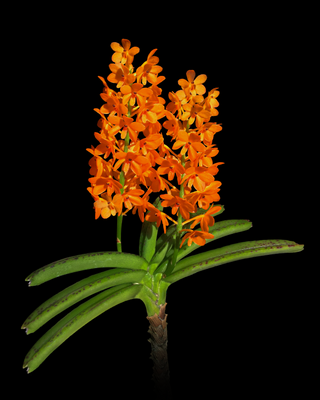
A raceme or racemoid is an unbranched, indeterminate type of inflorescence bearing flowers having short floral stalks along the shoots that bear the flowers. The oldest flowers grow close to the base and new flowers are produced as the shoot grows in height, with no predetermined growth limit. Examples of racemes occur on mustard and radish plants.

Carex flacca, with common names blue sedge, gray carex, glaucous sedge, or carnation-grass,, is a species of sedge native to parts of Europe and North Africa. It is frequent in a range of habitats, including grasslands, moorlands, exposed and disturbed soil, and the upper edges of salt marshes. It has naturalized in eastern North America.
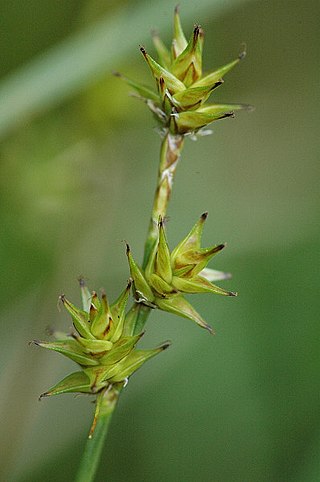
Carex echinata is a species of sedge known by the common names star sedge and little prickly sedge.

Carex limosa is a species of sedge known as bog-sedge, mud sedge, and shore sedge.
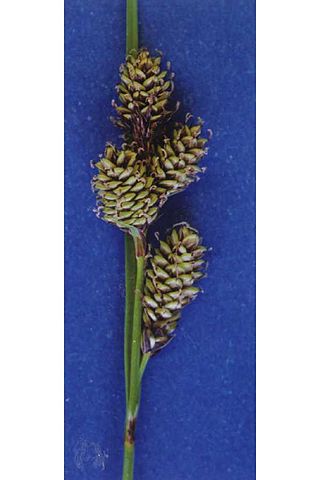
Carex heteroneura is a species of sedge known by the common name different-nerve sedge. It is native to western Canada and the western United States, where it grows in moist mountain habitat such as forests and meadows.

Carex hoodii is a species of sedge known by the common name Hood's sedge. It is native to western North America from Alaska to Nunavut to California to South Dakota, where it grows in dry to moist habitat in forests and on mountain slopes.

Carex leptalea is a species of sedge known by the common names bristly-stalked sedge and flaccid sedge. It is native to much of North America including most of Canada, the Dominican Republic, and the United States. It only grows in wetlands. This sedge produces dense clusters of thin stems up to 70 centimeters tall from a network of branching rhizomes. The thin, deep green leaves are soft, hairless, and sometimes drooping. The inflorescence is up to 16 millimeters long but only 2 to 3 millimeters wide, and is yellow-green in color. There are only a few perigynia on each spikelet, and they are green and veined.
- Carex leptalea subsp. harperi(Fernald) W.Stone - southeastern US from Texas and Florida north to Missouri and Pennsylvania
- Carex leptalea subsp. leptalea - widespread from Alaska east to Nunavut and south to California and Dominican Republic
- Carex leptalea subsp. pacificaCalder & Roy L.Taylor - Washington State, British Columbia, southeastern Alaska
Carex klamathensis is a rare species of sedge known by the common name Klamath sedge. It is known from 15 or fewer populations in southern Oregon and three populations in the Klamath Region of northern California. It was described to science only in 2007. Its habitat includes fens and other wet habitat, on serpentine soils. It was discovered independently by botanists Peter Zika and Lawrence Janeway.

Carex lutea is a rare species of sedge known by the common names golden sedge and sulphur sedge. It is endemic to North Carolina, where it is known only from Pender and Onslow Counties in the Cape Fear River watershed. There are nine populations. The plant was discovered in 1991 and described to science as a new species in 1994, and it has not been thoroughly studied nor completely surveyed yet. Its rarity was obvious by 2002, however, when it was federally listed as an endangered species.

Carex sect. Ovales is a section of the genus Carex, containing around 85 species of sedge. It is the most diverse section of the genus in North America, containing 72 species:

Carex lacustris, known as lake sedge, is a tufted grass-like perennial of the sedge family (Cyperaceae), native to southern Canada and the northern United States. C. lacustris us an herbaceous surface-piercing plant that grows in water up to 50 cm (1.6 ft) deep, and grows 50–150 cm (1.6–4.9 ft) tall. It grows well in marshes and swampy woods of the boreal forest, along river and lake shores, in ditches, marshes, swamps, and other wetland habitat. It grows on muck, sedge peat, wet sand or silt, in filtered or full sunlight.

Carex pulicaris, the flea sedge, is a species of sedge in the genus Carex native to Europe.

Carex appressa, the tall sedge, is a species of flowering plant in the family Cyperaceae. It is native to New Guinea, Australia, New Zealand, and generally in the South West Pacific.

Carex rosea, the rosy sedge, is a flowering plant and part of the family Cyperaceae. Synonyms for Carex rosea include Carex concoluta, and Carex flaccidula. It is native to central and eastern North America and it exists in wet to dry soils. Carex rosea can be found in shores of streams and bottomlands, as well as ponds. It is known to have good adaptations to dry-shade locations. It is an evergreen plant which is easy to grow.

Carex davisii, known as Davis' sedge or awned graceful sedge, is a species of Carex native to North America. It is listed as an endangered, threatened, or species of concern across much of edge of its range. It was named in the 1820s by Lewis David de Schweinitz and John Torrey in honor of Emerson Davis (1798–1866), a Massachusetts educator and "enthusiastic student of the genus" Carex.
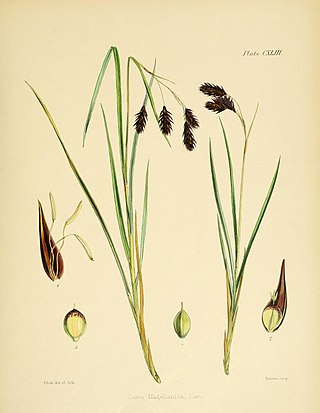
Carex magellanica, or the boreal bog sedge, is a Carex species that is native to North America. It is listed as endangered in Connecticut.
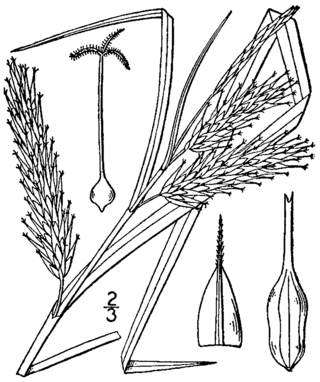
Carex schweinitzii, common name Schweinitz's sedge, is a Carex species native to North America. It is a perennial.

Carex brevior, known as shortbeak sedge and plains oval sedge, is a species of sedge native to North America. The specific epithet brevior means "shorter" in Latin.
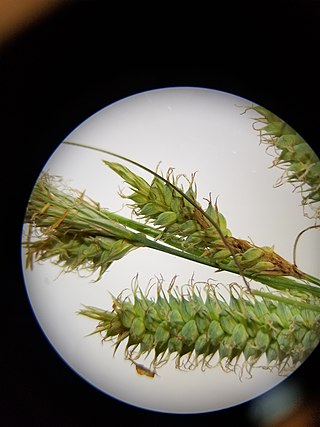
Carex glaucescens is a perennial sedge that belongs to the family Cyperaceae. The common name of this sedge is the southern waxy sedge due to the blue-grey, waxy appearance of the sheaths and fruits. The term "glaucous" means "gleaming" or "grey" in Latin; the specific epithet of C. glaucescens is derived from this term. Carex glaucescens is a native plant in North America and is an obligate wetland species in the Atlantic and Gulf Coastal Plains, Eastern Mountains and Piedmont, and the Great Plains.

Carex uruguensis is a tussock-forming species of perennial sedge in the family Cyperaceae. It is native to parts of South America.



















